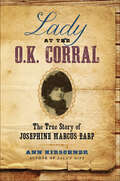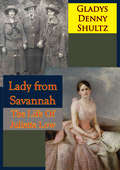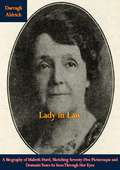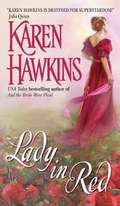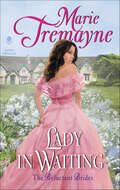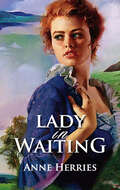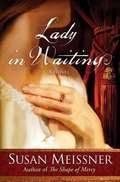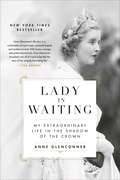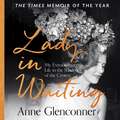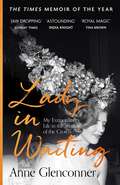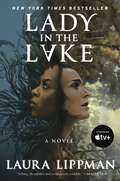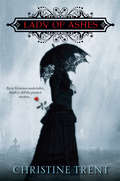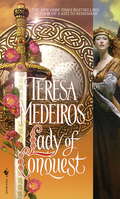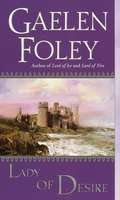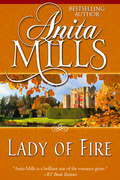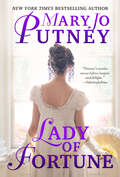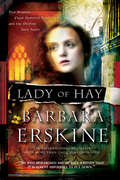- Table View
- List View
Lady at the O.K. Corral: The True Story of Josephine Marcus Earp
by Ann KirschnerThe definitive biography of the Jewish girl from New York who won the heart of frontier lawman Wyatt Earp: &“Splendid.&” —The Wall Street Journal For nearly fifty years, she was the common-law wife of Wyatt Earp: hero of the O.K. Corral and the most famous lawman of the Old West. Yet Josephine Sarah Marcus Earp has nearly been erased from Western lore. In this biography, the author of the acclaimed Sala&’s Gift brings Josephine out of the shadows of history to tell her colorful tale of ambition, adventure, self-invention, and devotion. Reflective of America itself, her story brings us from the post–Civil War years to World War II, and from New York to the Arizona Territory to old Hollywood. Lady at the O.K. Corral reveals how this aspiring actress and dancer—a flamboyant, curvaceous Jewish girl with a persistent New York accent—landed in Tombstone; sustained a lifelong partnership with the complex and charismatic Wyatt Earp; and was equally at home in Alaskan Gold Rush boomtowns, opulent San Francisco hotels, mining camps, casinos, racetracks, boxing arenas, and back lots where she visited Cecil B. DeMille and Samuel Goldwyn. &“Kirschner has cleverly identified a parallel story buried under the debris of history: that of Josephine Marcus, for nearly 50 years Earp&’s common-law wife and a valiant frontierswoman in her own right.&” —The New York Times Book Review &“Scrumptious . . . This quick-paced biography has it all.&” —USA Today &“Kirschner&’s fascinating profile captures the restless spirit of the frontier as deftly as it does Josephine&’s energy, affection, and limitless appetite for adventure.&” —Publishers Weekly
Lady at the Window: A Novella (Paraclete Fiction)
by Robert WaldronLady at the Window chronicles the last Holy Week in Julian of Norwich's life. In her secret journal (because women are forbidden to write in English) the great English mystic chronicles her inner life, including her relationship with the "courteous Lord," who when she was young was a constant presence in her life, but now in her old age feels to be more of a constant absence, Deus Absconditus.There are two windows in Lady Julian's anchorage: one looks upon the interior of St. Julian's Church with its high altar and tabernacle; the other opens onto the city of Norwich with its publicans, sinners, poor, people in the marketplace, and neighbors. Among these there are those in deep distress who find their way to Lady Julian, now famous for her wisdom and holy counsel. There is the young woman with a child outside of marriage. There is a wounded young soldier, jobless, homeless, and afraid. There is a man who has betrayed his betrothed. And others. No one leaves Julian's window without psychological and spiritual uplifting.But the underlying theme of this novella is Lady Julian's dark night of the soul. As with other mystics who came after her, e.g., St. John of the Cross and St. Teresa of Calcutta, Julian abides in a cloud of unknowing, praying daily that her darkness be dispelled by divine light.
Lady from Savannah: The Life Of Juliette Low
by Gladys Denny Shultz Daisy Gordon LawrenceThis autobiography tells the story of Juliette Gordon Low, the founder of Girl Scouts of the USA with the help of Sir Robert Baden-Powell, the founder of the Scouting Movement. But this is much more than the story of one woman and the organization she started: it is first of all a chronicle of two great American families--the Kinzies, who were founders of Chicago, and the Gordons, whose name is magic to this day in Savannah, Georgia--that in 1860 produced the gallant, willful, exasperating, generous, and wholly lovable Juliette (known as Daisy) Gordon. The narrative of Daisy's marriage to Willy Low also offers insider's view of Edwardian high society in England. The Girl Scouts are most particularly proud that this woman from a background of wealth and privilege was able to envision a youth movement "for the girls of all America," which serves a membership of ever-increasing diversity as the diversity of our country grows.
Lady from Savannah: The Life of Juliette Low
by Gladys Denny Shultz Daisy Gordon LawrenceBased on extensive research, this is a detailed biography of Juliette Low and a portrait of her family and background. Known throughout her life as "Daisy," Low was born in Savannah, GA, in 1860 and grew up amid privilege and comfort. She married into the British aristocracy. In midlife, after her husband's death due to alcoholism, she determined that she wanted to make a contribution to the world and hurled herself into the British Girl Guide movement. In 1912 she brought the movement to the U.S. as the Girl Scouts. The book draws upon Low's rich correspondence and the letters and diaries of her parents and siblings. /
Lady in Law: A Biography of Mabeth Hurd, Sketching Seventy-Five Picturesque and Dramatic Years As Seen Through Her Eyes
by Darragh Aldrich1950 biography by American author Darragh Aldrich on Mabeth Hurd (1869-1961), a member of the Minnesota House of Representatives from 1923-1945 and one Minnesota’s first four woman legislators.Mabeth Hurd was born in Newburyport, Massachusetts, in 1869. She attended the University of Nebraska-Lincoln, followed by the Massachusetts Art School in Boston, and studied at the Académie Julian in Paris, France. When she returned to the United States in 1891, she moved to Minneapolis and accepted a job teaching art in the Minneapolis public schools. In 1895 she married James Paige, a professor of law at the University of Minnesota, who encouraged Mabeth to obtain a law degree.In 1914 Hurd was asked to become president of the Women’s Christian Association in Minneapolis and founded the Minneapolis chapter of the Urban League, where she was a board member for 25 years. In 1922 Hurd filed for the office of Representative of the 30th Legislative District of the State of Minnesota, and that November she was elected as one Minnesota’s first four woman legislators, alongside Hannah Kempfer, Sue Metzger Dickey Hough, and Myrtle Cain.As the chair of the public welfare and social legislation committee, she introduced bills that outlawed “loan sharks” charging high interest rates that she believed helped keep people in poverty. She also passed bills that shortened the work week for girls and women who worked 10-13 hours each day seven days a week.In 1949, at the state centennial banquet commemorating Minnesota’s admission as a state, the Minnesota Junior Chamber of Commerce named Mabeth Hurd as one of eight women among the Hundred Living Great Minnesotans.
Lady in Red (Talisman Ring #5)
by Karen HawkinsUSA Today bestseller Karen Hawkins brings us another breathtaking and imaginative tale, full of her trademark wit and humour. Wealthy, powerful Marcus St. John has the golden touch. He has never, ever been on the verge of failure . . . until now. The famed St. John talisman ring has fallen into the clutches of Miss Honoria Baker-Sneed, a winsome, annoying woman who will not relinquish the treasure unless Marcus St. John agrees to sponsor her sister into society. He refuses until a heated argument ends in a stolen kiss . . . And more. Marcus and Honoria are caught in a compromising position and must marry. Marcus finds his pristine palatial house invaded by his new wife, her lively family, their pets and servants. Mischief and mayhem ensue . . . especially at night. In bed and out, Marcus finds Honoria his equal in every way, until he discovers that her heart might be too stubborn to let him in. Determined, Marcus sets out to win the one thing he cannot bear to lose: his own wife - the only woman he has ever loved.
Lady in Red: A Novel of Mad Passions
by Máire ClaremontThe Victorian era was full of majestic beauty and scandalous secrets--a time when corsets were the least of a woman's restrictions, and men could kill or be killed in the name of honor.... Lady Mary Darrel should be the envy of London. Instead, all society believes her dead. For Mary holds a secret so dangerous, her father chose to keep her locked away...and have a grave made for her near her mother's. Driven to the edge of desperation, Mary manages to escape the asylum, only to find that her fate yet again rests in the hands of a man... Edward Barrons, Duke of Fairleigh, longs for some way to escape the torment of his father's crimes. In Mary's warrior spirit and haunted gaze--which so mirrors his own--he finally sees his path to redemption. He will stop at nothing to keep her safe, even as she seeks revenge. But will the passion they discover in each other be enough to save them from their demons?
Lady in Waiting
by Kathryn CaskieShe is Lady Genevieve by day. And Lady Eros by night. What will happen when he discovers...she is neither? Meet the matchmaking Feathertons' maid, Jenny Penny, who agrees to pose as highborn lady to snare the affections of a wickedly handsome Scottish viscount. But Jenny is hiding an even bigger secret. She is also the notorious creator of an aphrodisiac cream that suddenly has all of Society abuzz...and tingling. Soon her double life is threatened and Jenny cannot help but wonder if the viscount will still love her when he discovers she is not the true lady she pretends...but rather a lady's maid.
Lady in Waiting (Reluctant Brides #1)
by Marie TremayneRITA Award WinnerShe wants to escape her present . . .When Clara Mayfield helps her sister elope, she’s prepared for the scandal to seal her fate as a spinster. What she doesn't expect is to find herself engaged to the vile Baron Rutherford as a means of salvaging her family's reputation. Determined not to be chained to a man she loathes, Clara slips out of Essex and sheds her identity: she becomes Helen, maid at the Earl of Ashworth’s country estate. After all, below stairs is the last place anyone would think to look for an heiress . . .He wants to forget his past . . . William, Lord Ashworth, is attempting to rebuild his life after the devastating accident that claimed the lives of his entire family, save his beloved sister and niece. Haunted by memories of what was and determined to live up to the title he never expected to inherit, William doesn’t have time for love. What he needs is a noble and accomplished wife, one who can further the Ashworth line and keep the family name untarnished . . .Together, can they find the perfect future?From their first encounter, the attraction between them is undeniable. But Clara knows William is falling for Helen, a woman who doesn’t even exist. The question is, if she reveals the truth about her identity, can she trust the broken William to forgive her lie and stand by her side when scandal—and the baron—inevitably follow her to his door?
Lady in Waiting (The\elizabethan Season Ser. #2)
by Anne HerriesIn the heated summer of Elizabeth I’s reignHer hopes of marriage dashed by scandal, the crown under constant threat, Queen Elizabeth I takes a young, spirited woman into her close court circle.On her way to being presented at court, Catherine Moor fights back with spirit when she is attacked in a teeming London street. Tales of Cat’s adventure reach the queen, who-impressed with the young woman’s lively mind-claims her as a lady of the bedchamber. Alert against plots that threaten to overthrow the crown, Cat realizes everyone is suspect. Even the flatteringly attentive Sir Nicholas Grantly, a seductive rogue, has secrets to hide beneath his charming exterior....The Elizabethan SeasonGlory and tragedy, love and betrayal in the age of Elizabeth
Lady in Waiting: A Novel
by Susan MeissnerLove is a choice you make every day. Content in her comfortable marriage of twenty-two years, Jane Lindsay had never expected to watch her husband, rad, pack his belongings and walk out the door of their Manhattan home. But when it happens, she feels powerless to stop him and the course of events that follow Brad's departure. Jane finds an old ring in a box of relics from a British jumble sale and discovers a Latin inscription in the band along with just one recognizable word: Jane. Feeling an instant connection to the mysterious ring bearing her namesake, Jane begins a journey to learn more about the ring--and perhaps about herself. ~ In the sixteenth-century, Lucy Day becomes the dressmaker to Lady Jane Grey, an innocent young woman whose fate seems to be controlled by a dangerous political and religious climate, one threatening to deny her true love and pursuit of her own interests. As the stories of both Janes dovetail through the journey of one ring, it becomes clear that each woman has far more infl uence over her life than she once imagined. It all comes down to the choices each makes despite the realities they face.
Lady in Waiting: My Extraordinary Life in the Shadow of the Crown
by Anne Glenconner<P><P>An extraordinary memoir of drama, tragedy, and royal secrets by Anne Glenconner--a close member of the royal circle and lady-in-waiting to Princess Margaret. As seen on Netflix's The Crown.Anne Glenconner has been at the center of the royal circle from childhood, when she met and befriended the future Queen Elizabeth II and her sister, the Princess Margaret. Though the firstborn child of the 5th Earl of Leicester, who controlled one of the largest estates in England, as a daughter she was deemed "the greatest disappointment" and unable to inherit. <P><P>Since then she has needed all her resilience to survive court life with her sense of humor intact. A unique witness to landmark moments in royal history, Maid of Honor at Queen Elizabeth's coronation, and a lady in waiting to Princess Margaret until her death in 2002, Anne's life has encompassed extraordinary drama and tragedy. <P><P>In Lady in Waiting, she will share many intimate royal stories from her time as Princess Margaret's closest confidante as well as her own battle for survival: her broken-off first engagement on the basis of her "mad blood"; her 54-year marriage to the volatile, unfaithful Colin Tennant, Lord Glenconner, who left his fortune to a former servant; the death in adulthood of two of her sons; a third son she nursed back from a six-month coma following a horrific motorcycle accident. <P><P>Through it all, Anne has carried on, traveling the world with the royal family, including visiting the White House, and developing the Caribbean island of Mustique as a safe harbor for the rich and famous-hosting Mick Jagger, David Bowie, Raquel Welch, and many other politicians, aristocrats, and celebrities. With unprecedented insight into the royal family, Lady in Waiting is a witty, candid, dramatic, at times heart-breaking personal story capturing life in a golden cage for a woman with no inheritance. <P><P><b>A New York Times Bestseller</b>
Lady in Waiting: My Extraordinary Life in the Shadow of the Crown
by Anne GlenconnerThe remarkable life of Lady in Waiting to Princess Margaret who was also a Maid of Honour at the Queen's Coronation - and is a character in The Crown this autumn. Anne Glenconner reveals the real events behind The Crown as well as her own life of drama, tragedy and courage, with the wonderful wit and extraordinary resilience which define her.Anne Glenconner has been close to the Royal Family since childhood. Eldest child of the 5th Earl of Leicester, she was, as a daughter, described as 'the greatest disappointment' by her family as she was unable to inherit. Her childhood home Holkham Hall is one of the grandest estates in England. Bordering Sandringham the Princesses Elizabeth and Margaret were frequent playmates. From Maid of Honour at the Queen's Coronation to Lady in Waiting to Princess Margaret, Lady Glenconner is a unique witness to royal history, as well as an extraordinary survivor of a generation of aristocratic women trapped without inheritance and burdened with social expectations. She married the charismatic but highly volatile Colin Tennant, Lord Glenconner, who became the owner of Mustique. Together they turned the island into a paradise for the rich and famous, including Mick Jagger and David Bowie, and it became a favourite retreat for Princess Margaret. But beneath the glitz and glamour there has also lurked tragedy. On Lord Glenconner's death in 2010 he left his fortune to a former employee. And of their five children, two grown-up sons died, while a third son had to be nursed back from a coma by Anne, after having suffered a near fatal accident. Anne Glenconner writes with extraordinary wit, generosity and courage and she exposes what life was like in her gilded cage, revealing the role of her great friendship with Princess Margaret, and the freedom she can now finally enjoy in later life. She will appear as a character in the new series of The Crown this autumn.(P) 2019 Hodder & Stoughton Ltd
Lady in Waiting: The charming, word-of-mouth bestseller, with over 500,000 copies sold
by Anne Glenconner**OVER HALF A MILLION COPIES SOLD****A TIMES MEMOIR OF THE YEAR **'The best royal book by miles . . . funny, gossipy and riveting'JANE RIDLEY, SPECTATOR'If your jaw doesn't drop at least three times every chapter, you've not been paying proper attention'SUNDAY TIMESA Maid of Honour at the Queen's Coronation and former Lady in Waiting to Princess Margaret, Anne Glenconner has spent her life as a friend of the royal family. In this bestselling memoir, she looks back on an extraordinary life full of glamour, drama and tragedy.The eldest child of the 5th Earl of Leicester, Anne knew as a daughter she would not inherit the family fortune and was instead brought up to secure an eligible husband. Her marriage to the charismatic Colin Tennant - later Lord Glenconner - would prove a test of every strength she possessed, while her friendship with Princess Margaret, which began in childhood, grew ever closer.From the tragic loss of two of her grown-up sons to the cruel surprise of her late husband's final will, Lady in Waiting is Anne Glenconner's remarkable testament to the resilience and humour that define her as she emerges from the shadow of her husband and the crown, reminding us that all that glitters is not gold.'A captivating account of a life lived with resilience and grace'DAILY MAIL'The stoical Lady G writes with infectious joy and optimism'DAILY EXPRESS'The gossip is stupendous but it's also tremendously touching. It's one of those books that makes you long for bed so you can read more!'JILLY COOPER'I can't recommend it highly enough'LORRAINE KELLY'Gentle, wise, unpretentious, but above all inspiring'THE TIMES'A candid, witty and stylish memoir'MIRANDA SEYMOUR, FINANCIAL TIMES'Stalwart and disarmingly honest . . . emotion resonates through this delightful memoir'THE WALL STREET JOURNAL'Discretion and honour emerge as the hallmarks of Glenconner's career as a royal servant, culminating in this book which manages to be both candid and kind'GUARDIAN'I couldn't put it down. Funny and touching - like looking through a keyhole at a lost world.'RUPERT EVERETT
Lady in the Lake: A Novel
by Laura LippmanSOON TO BE A SERIES FROM APPLE TV!A New York Times BestsellerThe revered New York Times bestselling author returns with a novel set in 1960s Baltimore that combines modern psychological insights with elements of classic noir, about a middle-aged housewife turned aspiring reporter who pursues the murder of a forgotten young woman. In 1966, Baltimore is a city of secrets that everyone seems to know—everyone, that is, except Madeline “Maddie” Schwartz. Last year, she was a happy, even pampered housewife. This year, she’s bolted from her marriage of almost twenty years, determined to make good on her youthful ambitions to live a passionate, meaningful life. Maddie wants to matter, to leave her mark on a swiftly changing world. Drawing on her own secrets, she helps Baltimore police find a murdered girl—assistance that leads to a job at the city’s afternoon newspaper, the Star. Working at the newspaper offers Maddie the opportunity to make her name, and she has found just the story to do it: Cleo Sherwood, a missing woman whose body was discovered in the fountain of a city park lake. If Cleo were white, every reporter in Baltimore would be clamoring to tell her story. Instead, her mysterious death receives only cursory mention in the daily newspapers, and no one cares when Maddie starts poking around in a young Black woman's life—except for Cleo's ghost, who is determined to keep her secrets and her dignity. Cleo scolds the ambitious Maddie: You're interested in my death, not my life. They're not the same thing. Maddie’s investigation brings her into contact with people that used to be on the periphery of her life—a jewelry store clerk, a waitress, a rising star on the Baltimore Orioles, a patrol cop, a hardened female reporter, a lonely man in a movie theater. But for all her ambition and drive, Maddie often fails to see the people right in front of her. Her inability to look beyond her own needs will lead to tragedy and turmoil for all sorts of people—including Ferdie, the man who shares her bed, a police officer who is risking far more than Maddie can understand.
Lady in the Navy
by Joy Bright HancockWhen legislation was passed in 1948 giving women permanent status in the regular and reserve Navy, it was largely due to the efforts of Joy Bright Hancock, the author of this revealing memoir. Her prominent role was acknowledged at the time by the secretary of the navy who credited her ideals, energy, and enthusiasm as the moving force behind the historic integration of women into the U.S. Navy, including the 1942 establishment of the WAVES (Women Accepted for Volunteer Emergency Service). This personal account of those formative years has long been considered the best study available. Originally published in 1972 and out of print for nearly twenty-five years, it is now being reissued in paperback to commemorate the sixtieth anniversary of the birth of the WAVES.Hancock's own work as a Yeoman in World War I offered the armed services a lesson in the benefits of having women in uniform. Her descriptions are eye opening of those early days and her later efforts, when finally in a position of authority, to argue the case for women. With a wealth of documentation and numerous photographs, she chronicles not only her career but also the evolution of Navy women, offering colorful details of the legislative battles to get women admitted into the regular Navy. She reminds us that although it was not until 1967 that the last restriction of rank was removed, WAVES always served with equal pay for equal work. This new edition of her book will introduce generations of Americans to the problems of establishing a place for women in the Navy and details of Hancock's dogged pursuit of fair treatment for women in the armed services.
Lady of Ashes: A Lady Of Ashes Mystery (A Lady of Ashes Mystery #1)
by Christine TrentA female undertaker in Victorian London suspects death by unnatural causes in a mystery &“rich with historical incidents and details&” (Publishers Weekly). Only a woman with an iron backbone could succeed as an undertaker in Victorian England, but Violet Morgan takes great pride in her trade. While her husband, Graham, is preoccupied with elevating their station in society, Violet is cultivating a sterling reputation for Morgan Undertaking. She is empathetic, well-versed in funeral fashions, and comfortable with death&’s role in life—until its chilling rattle comes knocking on her own front door. Violet&’s peculiar but happy life soon begins to unravel as Graham becomes obsessed with his own demons and all but abandons her as he plans a vengeful scheme. And the solace she's always found in her work evaporates like a departing soul when she suspects that some of the deceased she's dressed have been murdered. When Graham disappears, Violet takes full control of the business and is commissioned for an undertaking of royal proportions. But she's certain there's a killer lurking in the London fog, and the next funeral may be her own. With equal parts courage, compassion, and intrigue, Christine Trent tells an unrestrained tale of love and loss in the rigidly decorous world of Victorian society.Praise for the novels of Christine Trent &“Genuinely engrossing.&”—Publishers Weekly &“Exuberant, sparkling, beguiling. . .brims with Dickensian gusto!&”—Barbara Kyle, author of The Queen's Lady &“Winningly original…glittering with atmospheric detail!&”—Leslie Carroll, author of Royal Affairs
Lady of Conquest
by Teresa MedeirosShe had the fierce spirit of a warrior--and the passionate heart of a woman in love. He is called Conn of the Hundred Battles, the warrior-king who forged a nation from a land of isolated clans. As High King of Ireland, he rides with the legendary Fianna, his elite band of warriors. But a threat to the throne looms from a mysterious scourge who has vanquished several of Conn's bravest warriors. Conn rides out alone to face a seemingly invincible foe, never expecting that he will confront a grief-maddened hellcat with emerald eyes and hair like liquid flame. . . . Wielding a sword called Vengeance, Gelina ó Monaghan has sworn to defeat the man she holds responsible for her family's ruin. She never dreamed she'd be bested by him in combat. . . and lose her heart in the bargain. Their forbidden passion will become a private war fought with swords and kisses, promises and betrayal--and surrender will be only the beginning. . . .
Lady of Desire (Knight Miscellany #4)
by Gaelen FoleyWith the smashing success of Lord of Fire and Lord of Ice, Gaelen Foley has confirmed her place as one of historical romance’s hottest talents. Now with Lady of Desire, a sizzling tale in which a fiery young temptress tames the king of thieves, she delivers her most enthralling–and smoldering–novel yet. . . .Impetuous Lady Jacinda Knight is the daughter of a scandalous woman. Though society predicts she’ll follow in her mother’s footsteps, the spirited beauty stands unashamed of her passionate nature. Then one night, in flight from a safe but loveless marriage arranged by her strict older brother, Jacinda finds herself alone on a dark and dangerous street face-to-face with Billy Blade, the notorious leader of a band of thieves. His stolen kisses awaken in her a longing for a man she can never possess. A handsome scoundrel running from a secret past, Billy Blade has never met a woman like Jacinda–her fiery innocence and blossoming sensuality set his rebel’s heart ablaze. Having turned his back on the privilege and power of his tyrannical father’s house years before, he vows to return to his rightful place and reclaim his title, Earl of Rackford–to win the love of the ravishing beauty who has stolen his heart . . .
Lady of Disguise (A Dericott Tale #6)
by Melanie DickersonOnly the hidden treasure will allow Louisa and her sister to gain their freedom.England, 1388: All her life, Louisa has dreamed of finding the rumored &“Giant&’s Treasure,&” a collection of ancient, lost riches said to be hidden on a mountaintop in Scotland, guarded by a fierce monster. It&’s a story her father used to tell her, and when he dies and she and her younger sister have to go live with their shiftless, greedy uncle, Louisa is determined to find that treasure. It&’s the hope that has kept her defying her uncle&’s efforts to marry her off to the highest bidder.After her uncle starts to parade Louisa&’s twelve-year-old sister Margaret in front of potential husbands, Louisa realizes she has no time to waste. She disguises herself as a boy and takes off for Scotland. But the road is a harsher place than she&’d imagined, and she is relieved to find a friend in the knight, Sir Charles, who goes along with her on her journey.Charles is intrigued by this young woman who claims her name is &“Jack&” and is set on going to Scotland. He goes along, pretending to believe she is a boy, in order to make sure nothing bad happens to her. As they meet new friends along the road, and as Louisa comes clean about her identity, the pair find themselves falling in love. But what will happen when they reach Scotland? Will they find their independence and the freedom to marry in the form of a buried treasure, or will the monster from Louisa&’s own past keep the young couple apart?A delightfully charming reimagining of &“Jack and the Beanstalk&” from New York Times bestselling author Melanie Dickerson.Sweet historical medieval romancePart of the Dericott series: Book 1: Court of Swans; Book 2: Castle of Refuge; Book 3: Veil of Winter; Book 4: Fortress of Snow; Book 5: Cloak of Scarlet; Book 6: Lady of DisguiseBook length: 73,000 wordsIncludes discussion questions for book clubs
Lady of Fire (The Fire Series #1)
by Anita MillsFirst in the epic medieval romance series: A passionate story of intrigue, chivalry, and forbidden love from the author of Fire and Steel. Beautiful Eleanor of Nantes is pursued by many great noblemen, including the evil Robert of Belesme and charming Prince Henry, son of William the Conqueror. But it is the dashing Roger FitzGilbert, born a bastard with no title to his name, who sweeps her off her feet. Their love may be forbidden, but their passion is undeniable . . . “Anita Mills makes a phenomenal debut . . . Splendid . . . A highly romantic, action-packed tale of enduring love.” —Romantic Times “For medieval romance lovers, this one should be on your keeper shelf . . . The story is rich in historic details with an intricately woven plot, fast-moving dialog and action. It’s a page-turner and so well written.” —Historical Romance Review with Regan Walker
Lady of Fortune
by Mary Jo PutneyTrue love crosses all boundaries in award-winning New York Times bestselling author Mary Jo Putney&’s captivating historical romance, in which a young countess flees revolutionary France for London, becomes a maid, learns about life downstairs, and finds unexpected love.A countess turned servant . . . Forced to escape the French Revolution, resilient young Comtesse Marie-Christine D'Estelle flees to London. But when she finds herself unexpectedly penniless, Christa hides her aristocratic background to become a lady's maid. . . . Until rebuffing advances from both her tyrannical mistress&’s husband and her lover gets Christa cast into the street—directly into a hero&’s arms . . . A Royal Navy commander . . . After a long absence, Captain Lord Alexander Kingsley has returned to England on medical leave. Now head of his family, he must take charge of his younger siblings. He feels a special duty to his sister Annabelle, a shy debutante in need of a maid. So Alex is delighted to discover that the intriguing, outspoken, and lovely young woman who serendipitously landed in his arms is in need of just such a position . . . The heart of a household . . . With her warmth, charm, and surprisingly refined intellect, Christa soon wins the hearts of all the Kingsleys—especially Alex. And while their mutual attraction deepens to something more, the gap in their social stations seems an impossible obstacle. Only when Alex and Annabelle become the targets of fortune hunters, will the truth about Christa have a chance to be revealed. But will it mean a chance for true love to triumph?
Lady of Hay
by Barbara ErskineAn iconic, groundbreaking novel about the power of destiny with more than 3 million copies sold. With a mesmerizing, wrenching story set both in the present day and the 12th century, Lady of Hay explores how Joanna, a journalist investigating hypnotic regression, plunges into the life of Matilda, Lady of Hay-who lived 800 years earlier. As she learns of Matilda's unhappy marriage, her love for Richard de Clare, and the brutal treatment she receives from King John, it seems that Jo's past and present are hopelessly entwined and that, centuries later, a story of secret passion and unspeakable treachery is about to begin again-and she has no choice but to brave both lives if she wants to shake the iron grip of history.
Lady of Horses (Epona #3)
by Judith TarrJourney back into the deep mists of time, enter the lives of a savage people whose rituals include human sacrifice and ritual cannibalism; a superstitious people who fear the magic of the Shamans who live among them; a patriarchal people who forbid women to be hunters, or go among the horse herds, or become shamans. Enter the frightening, powerful life of Sparrow, the daughter of the tribe's Shaman and a captive woman. She is destined to do all those things, for the Horse Goddess herself has come among the herds of the tribe in the form of a proud mare, and she has chosen Sparrow to be her servant and priestess. Lady of Horses is a passionately romantic book, a historically accurate book, and a wildly adventurous book. It is a love song to the ancient, mysterious bond between women and horses, and, like Marion Zimmer Bradley's Mists of Avalon, takes the reader back to a time of goddess worship and women's power.
